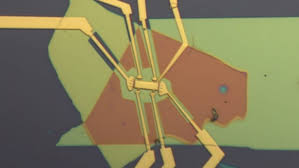
Breaking News
 Mike Benz just examined Epstein files and he's got a telltale theory…
Mike Benz just examined Epstein files and he's got a telltale theory…
 BREAKING GLOBAL EXCLUSIVE: Former High-Level CIA Operative Patrick Byrne Reveals That...
BREAKING GLOBAL EXCLUSIVE: Former High-Level CIA Operative Patrick Byrne Reveals That...
 Junk-food Bans for SNAP Users To Begin in January
Junk-food Bans for SNAP Users To Begin in January
Top Tech News
 EngineAI T800: Born to Disrupt! #EngineAI #robotics #newtechnology #newproduct
EngineAI T800: Born to Disrupt! #EngineAI #robotics #newtechnology #newproduct
 This Silicon Anode Breakthrough Could Mark A Turning Point For EV Batteries [Update]
This Silicon Anode Breakthrough Could Mark A Turning Point For EV Batteries [Update]
 Travel gadget promises to dry and iron your clothes – totally hands-free
Travel gadget promises to dry and iron your clothes – totally hands-free
 Perfect Aircrete, Kitchen Ingredients.
Perfect Aircrete, Kitchen Ingredients.
 Futuristic pixel-raising display lets you feel what's onscreen
Futuristic pixel-raising display lets you feel what's onscreen
 Cutting-Edge Facility Generates Pure Water and Hydrogen Fuel from Seawater for Mere Pennies
Cutting-Edge Facility Generates Pure Water and Hydrogen Fuel from Seawater for Mere Pennies
 This tiny dev board is packed with features for ambitious makers
This tiny dev board is packed with features for ambitious makers
 Scientists Discover Gel to Regrow Tooth Enamel
Scientists Discover Gel to Regrow Tooth Enamel
 Vitamin C and Dandelion Root Killing Cancer Cells -- as Former CDC Director Calls for COVID-19...
Vitamin C and Dandelion Root Killing Cancer Cells -- as Former CDC Director Calls for COVID-19...
 Galactic Brain: US firm plans space-based data centers, power grid to challenge China
Galactic Brain: US firm plans space-based data centers, power grid to challenge China
Twisted graphene exhibits previously-unseen form of magnetism

That's surprising enough, but it turns out this particular form of magnetism has previously only been theorized.
Since it's only one atom thick, graphene is effectively two-dimensional. That forces electrons traveling through it to only move along two axes, which in turn creates a host of unusual properties that have given graphene the moniker of a "wonder material."
From that starting point, graphene sheets can be stacked and manipulated in other ways to give it different abilities. In a study last year, an MIT team found that graphene could become a superconductor, meaning electricity passes through it freely with zero resistance. This was done by stacking two sheets and twisting them so their patterns don't quite line up, forming what's called twisted bilayer graphene.
The Stanford team set out to reproduce these results and build on them. In doing so, they accidentally made the graphene exhibit magnetism. They discovered this while sending an electrical current into a graphene sample, when a large voltage was detected perpendicular to the flow of the current. This normally needs a magnetic field to happen, but strangely the voltage stuck around when the external magnetic field was turned off. That means the graphene itself was generating an internal magnetic field.

 The Ever-Widening War
The Ever-Widening War

